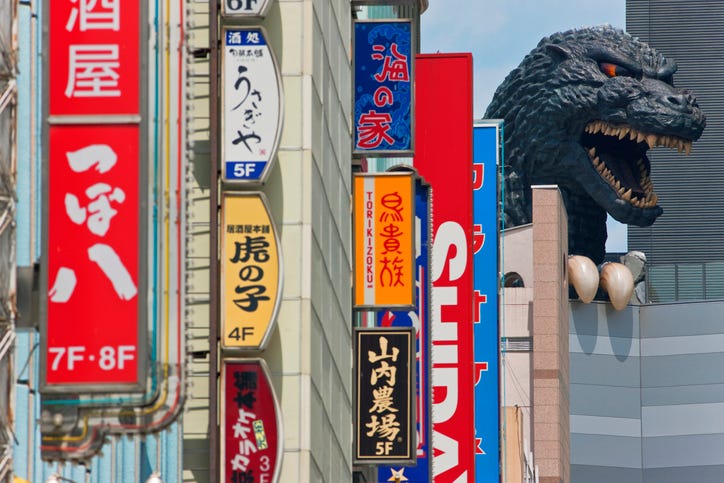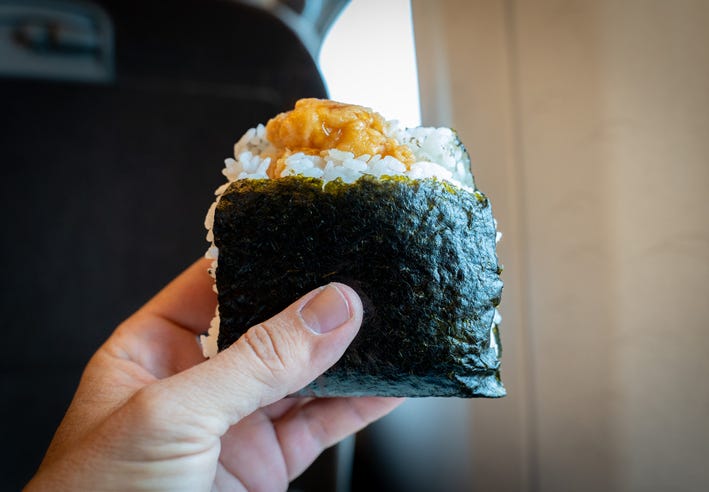Internal Success Before External Success
I had to go to the other side of the world to figure it out. Everyone else, read on.
A man runs into a bar and frantically motions toward the beer tap and says “Quick! Before it starts!”
The bartender, confused, gives the man a beer, which he quickly downs. He again points urgently toward the tap and repeats, “Quick! Before it starts!”, and the bartender gives him another.
When he finishes that, he says a third time, “Quick Before it starts!”, but the bartender had had enough.
He says to the man, “Before what starts?? But first though, are you going to pay for all these beers buddy?”
And the man looks up at the bartender dejectedly and says, “It starts.”
This was a joke told to me 21 years ago, by a Russian guy in an Irish bar in Japan. I remember it because of that weird context, and also because the Russian guy was my enemy.
That sounds made-up. But the details are true, except maybe the part about the guy being Russian (he might have been Ukrainian), and of him being my enemy (he was more like a rival).
Unauthorized Products, Inc.
I had been sent to Japan on a somewhat desperate mission. We had built a monolithic beast, and it was getting out of control. That image fits nicely into a Godzilla theme kind of deal given the Japan trip, but it was a real matter of life and death for the product we had been working on.
We were a remnant of a small startup buyout by a much bigger company, in an east-meets-west coast affair. Initially our Massachusetts outpost continued to function as a small company, not clued in to the goings-on of our California overlords. And they were not clued in to ours.
Our management team had worked for big companies before, but had little experience navigating the political waters of a large organization in their new, elevated VP roles at the new one. So when disagreements arose over the role our group should play as a new division of the company, our management did what they always had done: they just went their own way.
We had created an entire product without permission from our management, as it turns out. Quick. Before it starts.
A sort of desperate fight had been going on between our founders and that of the company that had absorbed us, to attempt to retain control of new product development. Our new overseers wanted to integrate our technology into existing products. We wanted to build a new one, to replace the existing product.
That kind of talk though did not sit well with our remote management, and proposals and meetings about it were getting nowhere. So we just built our product anyway, without telling them. And then our CTO and I flew to California and presented it in front of the company’s entire sales staff at the annual sales kickoff meeting.
The management was mortified. The sales staff was excited. We left that strange trip (which kind of deserves its own story, probably) elated. We had shown a live demo of the new product, doing things that the old one had promised for years but failed to deliver. The salespeople had naturally assumed we had the full backing of R&D management, and that this represented a new direction for the company. They wanted it immediately, and told our upper management as much. So the company R&D leadership basically had no choice, but to let us try to build it.
It was kind of a genius play, for dealing with the roadblocks we faced.
But fast forward, six months or so. Whatever had transpired between our founders and the company management in terms of fallout for our R&D product coup was not immediately obvious, to me at least. What was obvious though was that our fragile little prototype product was not holding up well to real-life customer demand pressure. The few installations of it were at projects in large Japanese semiconductor companies, and a host of issues had cropped up. Nothing really worse than the issues the companies other, main-line products, mind you. But being an unproven thing, doubts had been raised, and our product was now in serious jeopardy.
Strange Engineer in a Strange Land
Our former CTO who had started us on this unorthodox product journey had left the company to retire on his startup success in those intervening months. So I was picked as the sole R&D representative of our product to be sent on a trip to Japan, to visit both existing and possible future customers and convince them to adopt it. I went along with our east-coast Marketing guy Rich, and his west-coast partner from corporate, Larry.
Also along for the trip was a senior R&D architect from our west-coast headquarters, Mark. Mark was the maybe-Russian joke-telling guy from the start of this story, and was also a vocal critic of our product and R&D group’s efforts. He had worked on a similar product prior to ours, that never went anywhere. But he continued to advocate for developing it, instead of backing our product and approach. We kind of suspected he was secretly still working on his version, but he had nothing to show on this trip and was ostensibly sent along by our central management to collect customer requirements for future products in the same area.
Next thing you know, Rich and I are wandering around Tokyo Station in the middle of the night, dragging our luggage sleepily after a 17 hour flight and trying to find our way to the right floor, right platform, right train to get us to a much-needed bed.
There is a certain kind of stamina that one acquires when they do these types of trips frequently, it seems. One I lacked, being an R&D guy who usually stayed at home, and I struggled to keep up. I had also foolishly brought along a laptop briefcase, thinking it was going to set the right impression given the formality of these meetings — suits were not optional here.
But Rich and Larry were both sporting backpacks, which are kind of the norm now for travel gear, but not in 2000. When I asked if the customers would find them to be un-business-like, they shrugged and said, they just get tossed under the table as soon as you enter the room so no one cares. So I lugged around my big heavy 2000-era laptop in this briefcase all week with aching arms, watching these guys basically hike through Japan, comfortably geared up with laptop backpacks.
Our week was chock full of customer presentations across multiple cities, often with two visits per day. We soon met up with Larry and Mark, who flew in from California. We were also joined by Leo, our Irish ex-pat Field Engineer who now lived in Japan, and our local sales account manager, Okamoto-san.
Everyone here seemed to know what they were doing, except me. Mark knew which sidewalk vending machine dispensed the hot coffee-in-a-can he wanted, and Rich was able to find the local Starbucks every morning for his Cafe Mocha and two chocolate croissants, which he referred to as his daily “happy moment.” And everyone was better at finding and eating fish, seeing it was not a favorite of mine.
Larry was perhaps the most seasoned traveler among us and had mastered the art of petty embezzlement. I watched him buy a $70 fountain pen in Akihabara and proudly announce it was going to be expensed as “lunch”. When asked how he planned to get away with that, he showed me the receipt for it, which was entirely in Kanji. He said it looked just like lunch to him, and probably also to our engish-speaking Accounts Payable department.
It seemed pretty petty to me at least, given how much I assumed he was making. But I had bigger concerns, about how to present our product to customers. I was not given the job of showing slides, but to do a more impromptu whiteboard discussion of how it worked, kind of a “straight from the R&D guy” kind of thing.
At one of our first meetings, I stood at the front of an expansive conference room in the mid-century-modern office building of an electronics company in Shin-Yokohama. It was full of engineers and engineering managers who had come to hear about our latest product offerings, and I had been sent up to the front as kind of an intermission between slide shows.
I was drawing this architectural diagram of our system, trying to add in enough details to it to be convincing, without being confusing to people unfamiliar with it. As I awkwardly tried figure out a way to do this, Rich whispered to me from the front row.
“Draw bigger.” he said. I stepped back and realized my diagram was sized for an office, not a huge conference room, and nothing I was writing could really be resolved from the twenty or more feet away everyone was. I erased it, redrew, explained, took questions. It seemed to go okay.
In the back of the room though, Mark lurked. He did not present a thing, but did ask a lot of questions when we got to the Q&A. They were the kind of questions someone who is plotting a coup of their own might ask.
Bar Room Diplomacy
As we went to more sites, I got better at it. By mid-week, I was feeling pretty good about the customer responses we were getting, and Rich and I were discussing newly requested product features as we rode the Shinkansen bullet train, rocketing us down to Osaka at 200MPH for yet more meetings.
I had even gotten past my killer jet-lag, and could almost keep up with Rich and Larry, who were as far as I could tell business trip robotic systems who never really seemed to get tired. The customer visits down in Osaka seemed to go even better than the earlier ones, and Leo and Okamoto-san seemed happy enough about our performance on the trip.
We all went out to an Irish bar in Osaka our Field Engineer Leo liked to frequent, for an end-of-trip drink or two. Stepping in there was a sort of cognitive dissonance one can only arrive at when the immersive world of Japan suddenly vanishes before you and is replaced by Ireland. Leo introduced us to his buddies and we ate and drank and eventually got to joke-telling, and Mark shared the one in the opener of the article.
For a moment there, I thought maybe we could bury the hatchet between East and West, and I was not thinking Japan vs. US. I was thinking about Mark and I working together. I kind of extended an olive branch that night, and said I didn’t want us to be rivals. Not sure what I was expecting as a response, but I really did not get it. Mark just made some kind of snide comment about how we should have made a better product and then we wouldn’t need any help from him.
I was disappointed, but not as much as I would be later in the evening. We went back to the hotel, had one more drink at the rooftop bar overlooking the city lights, which featured amazing views and terrible Margaritas. (To this day, I don’t know what possessed me to order a Margarita in Japan).
Leo and Okamoto-san stopped by my room after that, as it was time to say goodbye. We talked for a bit about the week’s events. Okamoto-san was tipsy, and before leaving came stumbling out of my bathroom, closing the door behind him. “Don’t go in there.” he cautioned sternly. And then with a smirk, said goodbye, stumbled out into the hall, and hopefully into a taxi somewhere.
Leo and I laughed, and I remarked that it was the first time all week I saw the casual side of Okamoto-san. We had gotten along well, and it seemed to me like he was on board with our product. But Leo shook his head, pained look suddenly coming over him.
“Okamoto-san is not going to recommend your product to the sales force.” he admitted.
I was stunned, seeing how well things seemed to have played out with our customers. “What?? Why? Is it because of the bugs? We are working on those..” I started on.
“No. It’s because he doesn’t think it will be around in six months. He doesn’t think it has the backing of management.”
I really had no reply to that. Leo was of course correct, it really didn’t have Management backing, even still. And Mark’s presence on the trip came clearly into focus for me at that moment. They were going to build something else. And there was no way we were going to be able to hold onto this thing.
Back To Reality, Oops There Goes Gravity
I arrived home feeling somewhat defeated, but at least had a great non-fish meal. We continued to work on the product for months after that trip, but indeed it did not ultimately succeed in Japan or elsewhere, and the entire thing was canceled within six months. In its place, a new product was added, designed by Mark and a small R&D team on the west coast. He had quietly been working on it the entire time, but with little fanfare. No splashy demos. No customer pitches. He had management backing, and when it was ready, only then did it get shown to people. And the Salesforce started selling it.
Mark was an extremely smart guy but very hard to work with, with way too many Machiavellian tendencies for my tastes. His product made it further than ours, but was also replaced a few years down the road by yet other software. I admit to not being a huge fan of Mark, I think if we had collaborated maybe we could have gotten it right the first time.
But his technique for getting a product to market successfully at least is something I admired, and try to follow to this day. It’s called Internal Success before External Success in my book, and it means simply: get your shit together before you try to sell it to someone. Maybe the internal success you need to achieve is technical. Maybe it is political. But whatever it is, do it first, before expanding your reach.
I recently had the pleasure of working on a very successful product feature and was asked for a presentation I did to include a slide showing positive customer quotes. Also on the slide was to be a list of positive quotes from our internal Field Engineers who had gotten behind the product idea and who also had good things to say.
I put our Field Engineer quotes first on the slides, the Customer quotes second.
And when I presented that slide, I said it was arranged in order of importance. I’m not sure everyone understood why, though.
Explore Further
Next Time: Why would anyone design a nine-bit CPU? If you find out, let me know. Mine is in progress. Nerdy and needless exploration over well-traveled territory, and ruminations thereof in part one of a (hopefully-multi-part) series: Holy Nonads, a Nine Bit CPU!
The Mad Ned Memo is published on a (more or less) weekly basis and features nerdy tales and discussions of computer technology. It frequently trends on technology-loving social media sites like Reddit or Hacker News, but you don’t have to chance missing out on an issue if you subscribe! It is cost-free and ad-free, and you can unsubscribe at any time.
The Mad Ned Memo takes subscriber privacy seriously and does not share email or other personal information with third parties. For more information, click here.





